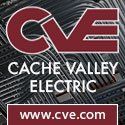Perfect Calling
The face of Utah's AGC chapter for four decades, Rich Thorn's positive impact on Utah's construction industry has been nothing short of legendary.
Capitalizing on his family’s good name—and his own gregarious, optimistic nature and personal charm—Rich Thorn has been among the most prominent advocates of Utah’s construction industry for more than 40 years.
As the President/CEO of the Associated General Contractors (AGC) of Utah, Thorn has been the proverbial face of the association since assuming the title of its top executive in October 1982—just before reaching 25 years of age. It has proven to be a role tailor-made to his
skills, education, and upbringing.
“Every day is a great day,” Thorn exclaimed during an early February phone call to discuss how he was feeling after AGC of Utah’s 100th-anniversary convention. Besides it being the coveted century mark in time, this year's event was particularly special to Thorn due to the remarkable turnout and energy level of those who attended.
“Our numbers [of attendees] were above those of pre-Covid numbers, and couple that with the companies who were sponsors, we were really happy with the turnout,” he said.
It was also significant in that it was his second-to-last AGC convention, as Thorn, 65, recently announced his retirement, effective at the end of the state’s legislative session in March 2023.
“I’d be less than honest if I didn’t feel some bit of nostalgia,” he said. “This is the next to last one; there is a lot of sentimental value, as I’ve been through a lot of these.”
Over the past couple of years, Thorn has been gradually handing over the reins of the chapter to long-time AGC of Utah Vice President Joey Gilbert, with Melissa Camp, Director of Finance and Administration, also filling a vital staff role. Gilbert and Camp were hired in 1997 and 2003, respectively, and have more than 40 years combined experience, yet are acutely aware it’s going to be challenging filling Thorn’s shoes.
“He’s the eternal optimist, liked by everyone,” said Gilbert, trying to sum up Thorn’s character in a few words. “He’s always upbeat and treats everyone like a best friend. I get that comment all the time.”
“I’ve been trying to convince him not to leave,” laughed Camp. “He cares—that’s the biggest thing. And cares not just professionally, but about your personal life. We’re calling this his ‘farewell tour.’ It’s hard for him 100% to step back, but he’s trying. He’s trying to take it all in and enjoy it.”
Ideal Upbringing included Construction and Politics
A native of Springville, a relatively small Utah town with a rich history of heavy/civil contractors, Thorn was born into a prominent construction family. Great-grandfather Ashel O. Thorn started Thorn Construction in the 1920s, with grandfather Paul Thorn (AGC of Utah President in 1947) and great-uncle Grant Thorn also running the firm for many years, before it closed in 1981.
His father, James (Jim) Thorn, worked at the company for many years as a laborer, heavy equipment operator, foreman, and superintendent/project manager. Fond memories from Rich’s youth include staying at motels during the summer in towns like Orderville in southern Utah and Delle in Utah’s west desert, while Jim managed paving jobs.
Thorn spent summers in high school and college working at Thorn Construction, learning how to operate loaders, dozers, and asphalt pavers—great hands-on experience of what happens in the field.
“For me, that’s always been helpful because I can relate to what that’s like,” he said. “I will never forget the guy wallowing in the mud, laying pipe, making it happen on the job site. That’s where the work gets done.”
One powerful early memory came via a job site visit with Grandpa Paul, on a day with rather inclement weather.
“It was a lousy, rainy, bad day,” Thorn recalled. “We pulled onto the job and Grandpa Paul was the executive. He was wearing brand new Florsheim shoes. He got out of the car and walked through the mud to shake the ‘Cat skinner’s hand. I will never forget that. He saw the value of the people he worked with, and that’s the term, he worked with them. The Thorn name meant a lot in the construction industry; our company had a good reputation.”
On the flip side, his mother, Karen, was perhaps even more influential on Thorn, given her vast political clout and lengthy career that included working for two U.S. Congressmen and two U.S. Senators for 35 combined years, in addition to serving on multiple community and political organizations. She was sharp, with an infectious smile and a keen ability to connect with people of all persuasions.
Karen’s career included working in Washington D.C., which uprooted the family from tiny Springville and had them living in the nation’s capital from 1961–1964, Thorn’s first three years in elementary school.
The experience was magical for young Rich, with “family field trips” most weekends to different historical U.S. sites. He’s been to D.C. dozens of times throughout his professional adult life. He cites D.C. as perhaps his favorite city.
“He’s his mother, through and through,” said Thorn’s wife of 43 years, Sherrie. “He’s got his dad’s [gift of gab] skills—he likes to talk—but he’s got his mom’s kindness. His mom was just genuine.”
Karen’s ties helped Thorn effectively navigate Utah’s political waters at an early age, and his 40 years of lobbying on Utah’s Capitol Hill has been consistent and effective, year after year. He’s been resigning from various labor and pension boards and other workforce and industry committees (upwards of 15-plus during peak years) while having Gilbert step in to fill the void.
“It’s all part of the plan,” Thorn said. “It’s flattering to be called by the Governor to serve on a board or as a chair of a committee. I feel obligated to serve and I’ll give it my best. It’s nice to have people ask for your opinion.”
Thorn remains engaged in this year’s legislative session, having been to Capitol Hill three times, and is reading legislation, giving input, and suggesting amendments while Gilbert is running point.
“I’m up there as his wingman,” said Thorn. “We talk every day. That’s part of the [transition] process. It’s been a bit of a learning curve for me to sit back.”
Family First
Thorn said the single greatest benefit of working for the AGC, for himself and Sherrie, was being able to comfortably raise their family of four children. They met at Dixie College in 1976—Thorn was on scholarship playing football and baseball—and married in June 1978.
In the fall of 1980, he got wind of a staff assistant position at AGC of Utah and was hired to work under Horace (Hod) Gunn on September 15. It proved to be a great fit, with Thorn’s construction background and jovial nature making him an instant asset to the association. When Gunn announced his retirement less than two years later, both Thorn and his wife felt he was ready to take over as AGC’s top executive. They weren’t sure the Executive Committee and Board of Directors felt the same way about a 25-year-old, but they were optimistic at his chances, nonetheless.
“We were hoping and praying he’d get it,” recalled Sherrie, “but he still had to compete with everyone else. He had an advantage because he had the [staff assistant] job for two years. He was a young buck, but he had the family name and he loved the job. He was a perfect fit.”
Thorn remembers interviewing with the search committee, including Walter Christiansen, Allen Young, John Tempest, and committee chair Ted Jacobsen. They told him, “We’re going to give a young guy a chance,” according to Thorn. “I believe the Thorn name and my mom’s political prowess neutralized the ‘He’s too young’ discussion. I knew a lot of [AGC] members on a first-name basis before I ever walked in the door. I also brought something they recognized—potential.”
He was named Executive Manager (later called Executive VP, then President/CEO in 2000) in October 1982 and poured his soul into the job. The construction industry was struggling at the time, with Utah and the US still reeling economically from the fallout after the Savings and Loan crisis.
“Life from September to January, they are so busy,” Sherrie said about convention prep. “It’s just nuts. It’s a lot of work for Rich, Melissa, Joey, and the staff. It’s crazy. That ends, and lobbying at the Capitol begins. Lobbying is not so bad now, but back in the day, Rich was (at the Capitol) morning, noon, and night.”
She credits Camp and Gilbert for their hard work and contributions to making the association better over the past two-plus decades. “Rich couldn’t have done it without them,” she said. “They are his right and left hand—they’re a team.”
Chips Off the ‘Ol Block
Thorn’s three sons—Cody, Brady, and Tyler—all ended up pursuing careers with ties to the construction industry, and speak glowingly of their father’s impact on their respective success.
“Everything I do has been by observing how my dad handles and treats people,” said Brady, Sr. Vice President at Murray-based Beehive Insurance. “As a result of that, my career has been very successful. I believe in the ‘Golden Rule’—you treat the janitor and the CEO with the same level of respect. People like it when they are appreciated and valued. I know my clients’ wives and friends, their victories and successes.”
“I was literally raised by the AGC,” said Tyler, Area Manager for Bridge Source. “I’ve attended conventions, conferences, and golf tournaments in a stroller, and now I attend those same functions with my wife, and we’ve taken our babies to conventions.”
Tyler continued, “From a son’s perspective, he has always been a selfless person. He was always available, always willing to help. You can tell that work meant a lot to him and he was good at it, but we were the top priority. He would move heaven and earth to go to anything we did—scout camps, baseball tournaments, everything. He’s available if I need to bounce an idea off him, but we always talk about other things …sports, politics. He’s well-rounded in that regard.”
“His support has been amazing with me starting a new company,” said Cody, who founded Thorn Milling & Construction in 2018. “I reached out to him many times if I was having a hard time with a particular project. He’s always told me to be calm and collected and keep your composure. People jump to conclusions way too quickly. Treat people the way you want to be treated, and surround yourself with people who will make you a better person.”
Cody added, “I’ve never seen dad lose his cool. Also, when it comes to his leadership role at AGC, people look up to him. They learn from him. When he speaks, he demands your attention. Plus, he’s a phenomenal listener.”
Thorn said he’s proud of his sons’ career accomplishments thus far, and also wanted to give a shout out to his daughter, Shelbie, and her husband, Chris Curtis. Shelbie and Chris are the proud parents of three children and reside in Salt Lake County. Shelbie said her father’s strong work ethic and ability to make friends are among his hallmarks, but “work was work, family came first.” As she got to be a teenager and hanging out with friends, her dad used to tell her “remember who you are. It’s just stuck with me. I’m a Thorn and we take pride in our name. I’m doing that now with my kids.”
A Legacy of Excellence
The AGC has long attracted the “best of the best” from Utah-based general contractors to lead the chapter, including company owners, presidents, CEOs, and other high-ranking executives that fill various executive committee and board of director positions annually.
So Thorn, needless to say, has worked with hundreds of talented, influential people over the years, spanning every type of construction—from general builders to highway and utility contractors, and everyone in between. Praise for his inclusive nature and effectiveness as the chapter’s long-time leader is found in spades.
“He’s an ‘A-game’ type of guy—and he does it with a smile on his face,” said Bob Tempest, former Vice President for Murray-based Tempest Enterprises, and a long-time advocate of AGC of Utah who served as Chair in 2011, and as a Lifetime Director for a decade.
“Rich has always demonstrated that he’s in the service of the industry,” said Tom Case, former Granite Construction executive and 2005 AGC of Utah Chair, who now operates TCM Services in Park City. “It’s through that service that he adds value to the members, and it’s why people keep coming back.”
Case, who also served as Director of the Highway/Transportation Division for AGC of America in 2014, said Thorn’s impact is recognized nationally by other chapters.
“I got to see other [AGC] chapters and how they do things, and I would say Utah is one of the best in the country, and that is a direct reflection on Rich, Joey, and the team.”
“To his fellow chapter executives, he is always willing to share what he and the Utah AGC does that is successful. At the same time, he’s not hesitant to listen and learn about what others are doing and bring that back to Utah,” said Ken Naquin, CEO of the AGC of Louisiana. “Rich has that innate sense of what makes an individual special and recognizes how to engage that talent. Rich has always positioned Utah AGC to be supportive of AGC of America—that is not easy to do.”
“I’m impressed with the network of people he cultivates and the relationships he maintains,” said Scott Parson, CEO of Staker Parson Materials & Construction of Ogden and 2022 AGC of Utah Vice Chair. “The construction industry is all about connection and relationships, and Rich epitomizes that.”
“Rich is one-of-a-kind and so focused on making our industry better,” said Rob Moore, Executive Chairman for Salt Lake-based Big-D Construction and 2010 AGC of Utah Chair. “He gets things done. He knows who to tap and who to talk to.”
“It’s easy to say good things about Rich,” said Doug Welling, former President/CEO of Jacobsen Construction of Salt Lake City and 2018 AGC of Utah Chair. “Rich has been interested, capable, invested, and energetic about our industry for many years. He never gets tired, never gets offended. He’s always at the forefront making things happen.”
Welling, who also took construction management courses at BYU with Thorn all those years ago, noted that a new slate of leaders is elected each year, and each person who serves as Chair has an agenda. Thorn’s ability to help new leaders maximize their calling is second to none.
Doug Watts, the former President/CEO of St. George-based Watts Construction and 2014 AGC of Utah Chair, expressed his appreciation for Thorn’s influence on his personal life.
“Rich came into my life at one of my darkest periods [...] and helped me believe I was still relevant,” said Watts. “He is generous, charitable, and never lets anyone down. He has been the best fit to lead the AGC of Utah […] and built it into a powerful, well-respected organization. He is a very good friend.”
“There are a lot of unique and wonderful things about Rich,” said Scott Okelberry, Executive Vice President and COO of Orem-based Clyde Companies, who served as 2021 AGC of Utah Chair. “As the President of this organization, he’s unmatched. We go to regional and national chapter leadership meetings and there are a lot of good leaders out there, but nobody stands above Rich Thorn. We’re fortunate in this industry to have a leader like him, somebody with his level of experience, his personality, his assertiveness, and his vision of this association. As he prepares to ride off into the sunset in just over a year, we have a very capable successor in Joey Gilbert, who is fully ready to take the reins.”
“It is difficult to imagine AGC and our Utah chapter without Rich,” said Stephen Sandherr, CEO of AGC of America. “He is such a tremendous force of nature, constantly plugging away at his job with his sunny disposition. He has definitely helped shape our association for the better, and is one of our better known and widely-respected chapter leaders. Filling his shoes won’t be easy, but if there is one thing we have learned about the AGC of Utah, there is no challenge too big for the chapter to overcome.”
Thorn was wistful in trying to sum up his AGC career.
“This has been a part of my genome for two-thirds of my life,” he said. “It’s filled with great memories. There will be some things I’ll miss. But I’ll look back and say we accomplished some pretty good things. I was the luckiest guy ever in that I got to do a job I absolutely loved.”

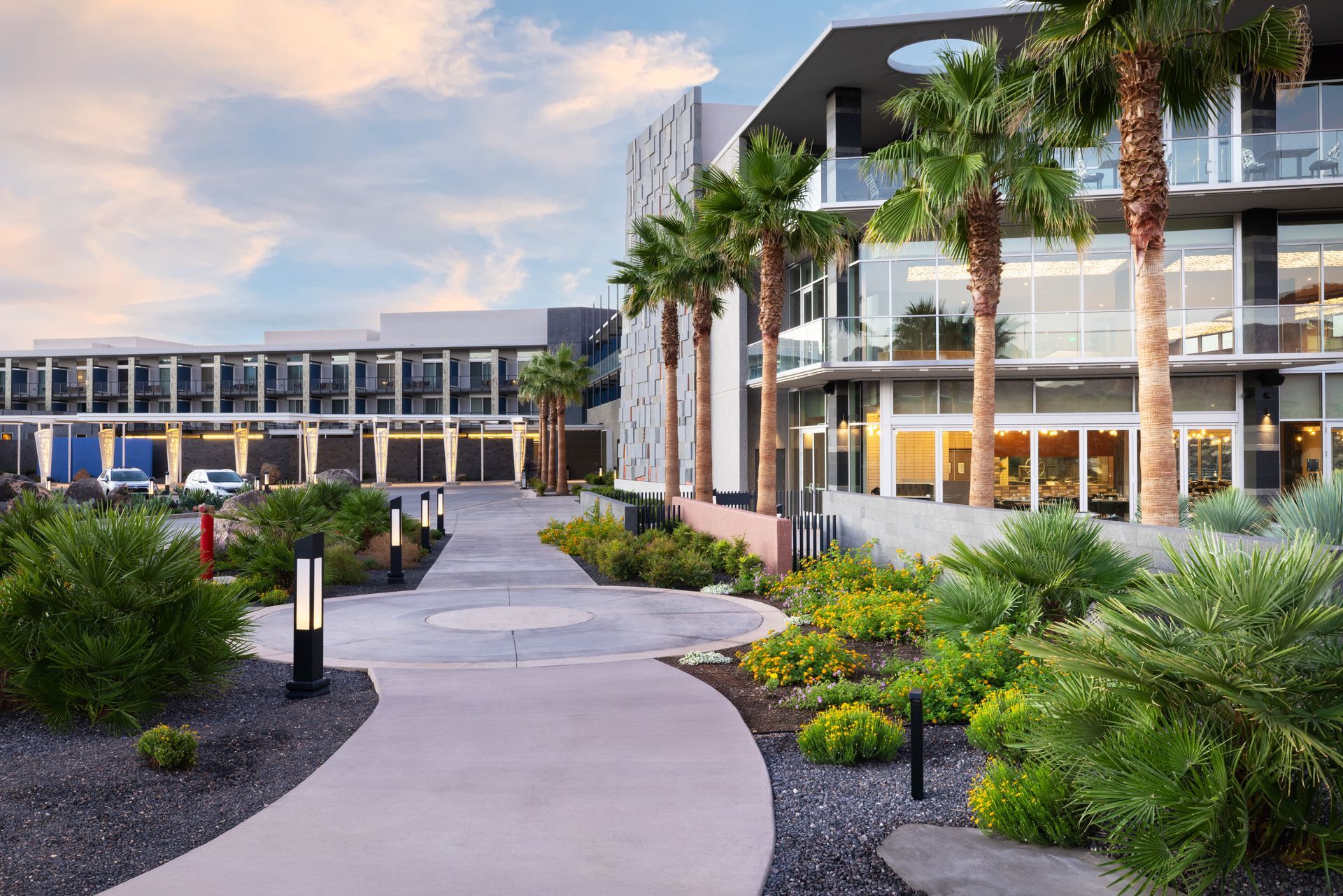
When Lehi-based Reef Capital Partners (Reef) initially announced plans in 2018 to build a sprawling, estimated $2 billion mega-resort with a championship-caliber golf course on 600 acres covering parts of Ivins and Santa Clara—small towns with just over 15,000 combined residents at the time—it was difficult to fathom what a project of that magnitude might look like. Fast forward seven years, and Black Desert Resort is indeed a shining oasis amidst Southern Utah's famed red rock cliffs, sitting atop an ancient lava field, with buildings strategically carved into the land to produce a resort unlike anything else. "This is the biggest project we've ever done—we feel really good where we are," said Brett Boren, President of Real Estate for Reef, acknowledging the general completion of the $290 million, 806,000-SF resort center, along with significant ongoing work—including a 1,298-stall parking garage, condominiums, and a private water park. As of September, all aspects of the main resort center were open and fully complete, with the hotel celebrating its first official year in business after partially opening in September 2024 as it hosted the inaugural PGA Black Desert Championship October 10-13. The second installment of the tournament—now dubbed the Bank of Utah Championship—is slated for October 23-26, with a third tournament signed for 2026.
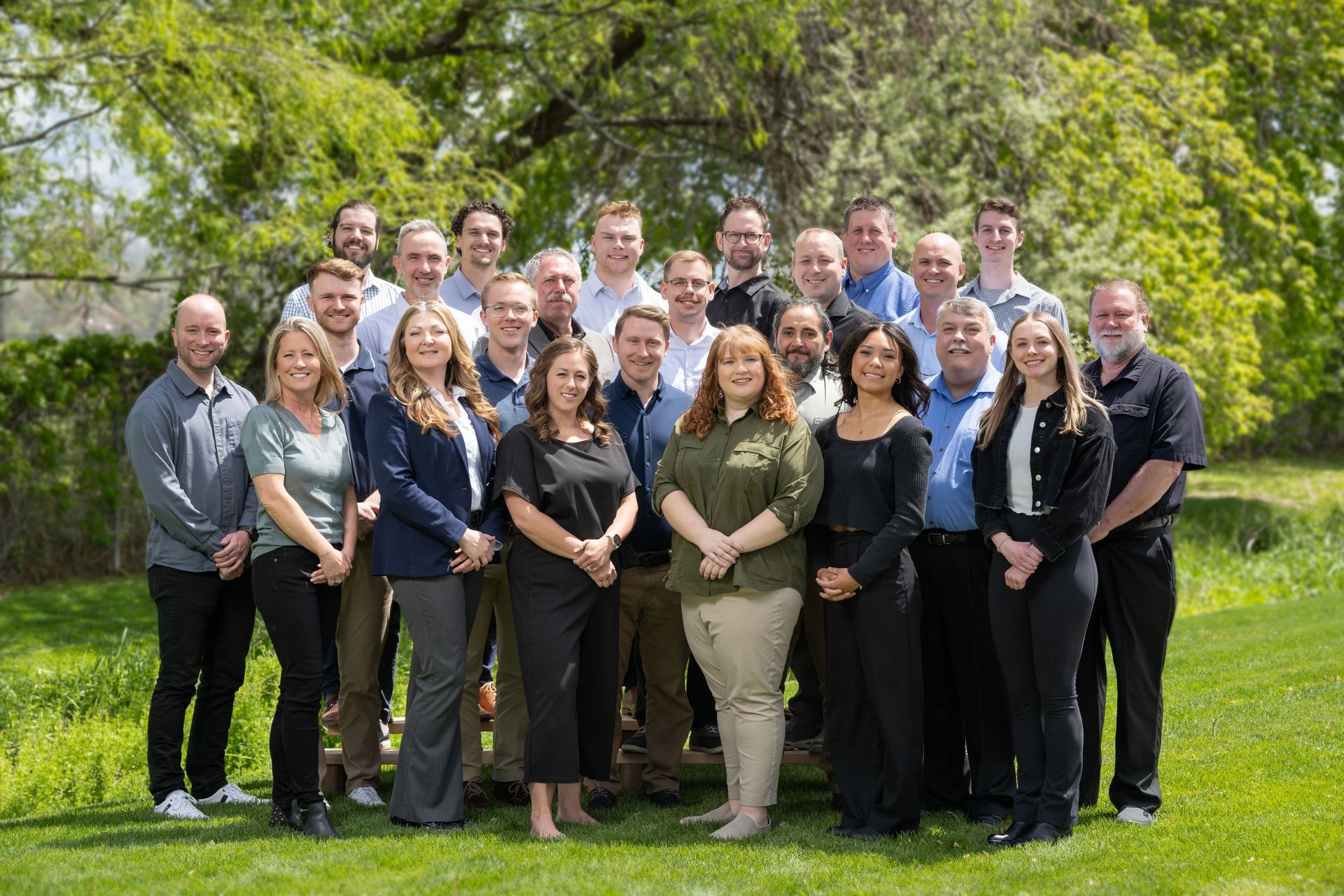
In 2005, Calder Richards Consulting Engineers formed after the merger of two smaller structural consulting firms who, interestingly enough, both started in 1986. Calder Richards has provided a steady structural support for Utah’s built environment ever since. As the firm celebrates its 20th anniversary, UC+D spoke with Managing Principals Shaun Packer and Nolan Balls to look back over the company’s history and celebrate what has helped their firm stand out to deliver solid projects in Utah and beyond. Their responses were edited for clarity and brevity. UC+D: What have been some catalytic moments for Calder Richards since that initial merger? SP: Winning the Talking Stick Resort in Scottsdale, Arizona is the first one. The big reason for the merger between Richards Consulting Group and Calder Consulting was to build a large enough company to go after bigger projects like that.” NB: That was my first project when I was hired straight out of college. We helped design the 17-story hotel and casino, a conference center, as well as parking structures, a central mechanical building, and a pool building. Talking Stick helped get us through the downturn a few years later. UC+D: What have been your key market sectors you all have targeted over the last 20 years? NB: We were breaking into K-12 along the Wasatch Front soon after the Talking Stick Resort and it’s been our bread and butter since then. SP: Absolutely, but I credit our firm for always adapting to the current environment. We’ve been fortunate to do so much K-12, but we used to do a lot of office work, and now we are working on conversions like the Ebay Headquarters to CTE/Innovation Center for Canyons School District as the market has shifted away from commercial office. UC+D: Schools have certainly evolved over the last 20 years, how has your work as structural engineers evolved? SP: We are seeing more creative design on the architectural side, certainly. We see many more two-story designs; more windows and daylighting. But we’re utilizing more powerful tools and continually building our understanding of the structural materials that are in use more than ever—tilt-up concrete, steel columns and beams, especially—to be the architect’s trusted partner. NB: Schools have definitely changed, and we’ve had better experience in helping projects move forward successfully when we are involved earlier in the design process. As we got involved early on in West High School’s schematic design, we were able to provide structural solutions and options to accommodate the architects’ design intent. UC+D: How has company growth changed Calder Richards? SP: It’s certainly changed the number of people in our office. We started with around 10 people when we merged, and today we have 27. But we often say that we don’t want to grow just to grow—we want to grow sustainably. We don’t lay people off when works slows down, and we have an expectation that sometimes there will be overtime work, and other times you may be waiting for our next project to begin.
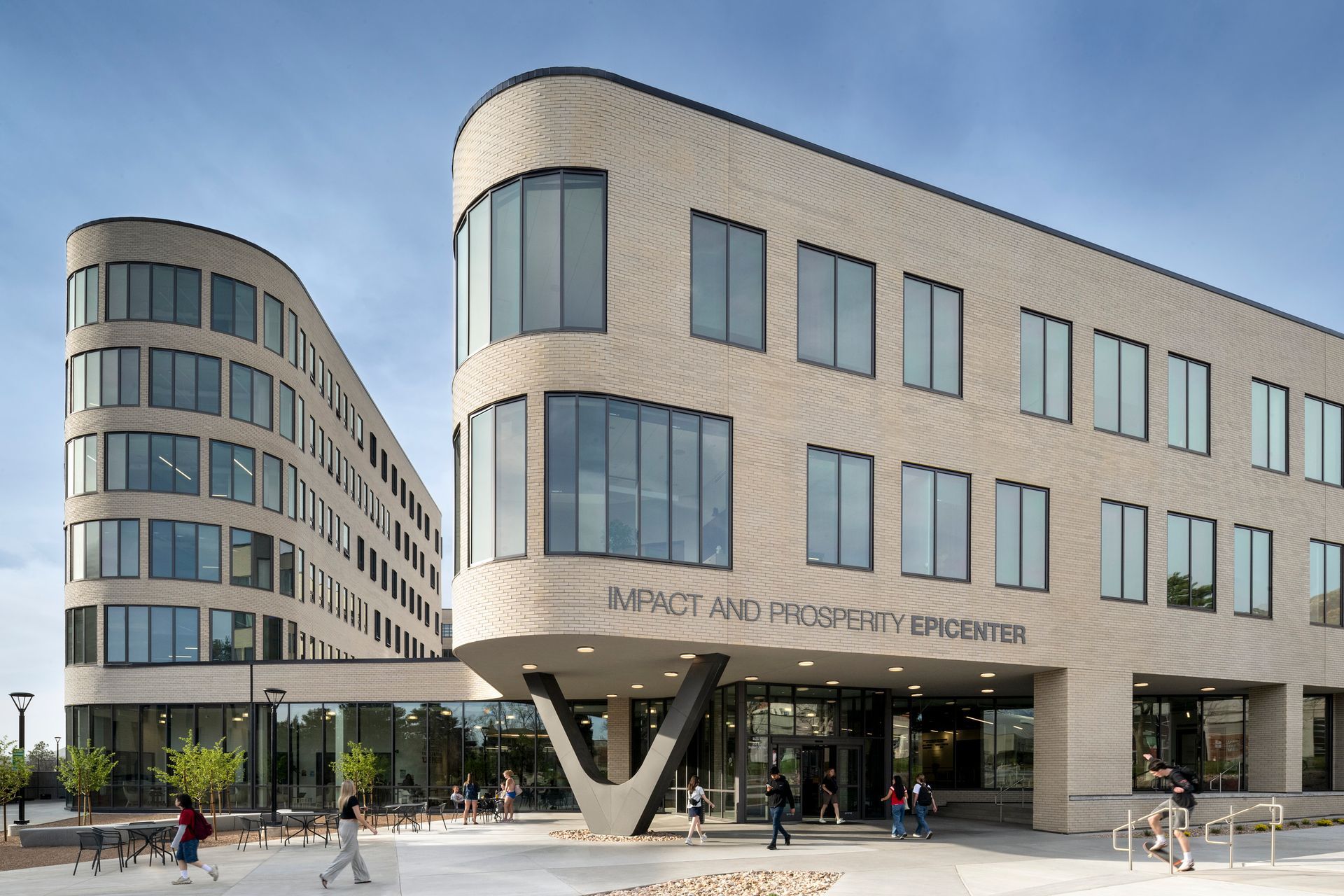
Nested in the middle of the University of Utah (U of U) campus sits the aptly-named Impact & Prosperity Epicenter, the second living learning community (LLC) project designed on campus by Los Angeles-based Yazdani Studio of CannonDesign. After nearly a decade since their first LLC project, the award-winning Lassonde Studios (UC+D’s 2016 Most Outstanding Public Building over $10 million), Mehrdad Yazdani, the design firm’s Principal and Studio Director, said their work on a sequel was an exciting prospect for the firm, and enlisted Salt Lake-based MHTN Architects and Okland Construction to serve as the respective local architect and general contractor. Today, the Epicenter serves as a striking piece of architecture and construction, one whose curvilinear shape asks users and visitors plenty of questions. But moving from idea to execution has been a work in progress. One query from Yazdani stood out as it relates to students and the built environment, and helped begin the journey to create the Epicenter: “How does your living environment as a student impact your success as a student and as a changemaker?” A Project for an Evolving Campus Katie Macc, CEO of the Sorenson Impact Institute, said LLCs like the Epicenter and Lassonde Studios next door have been massive steps forward in advancing entrepreneurship and social impact. But both play a major role in creating “college town magic”—a phrase coined by University President Taylor Randall that invokes a vibrant campus where students can find community and have one-of-a-kind experiences. With more on-campus student housing in the works, the state’s flagship university is hoping to shed the “commuter school” label and deliver a level of desirability that matches the resources students commit to higher education. “There is some soul searching going on across university campuses,” said Macc of the challenge at hand. “We have to be convincing that going to college matters.” She said overall university enrollments across the nation are decreasing as students grapple with tuition costs, COVID and its isolating aftershocks, and a different perspective on higher education. Universities are no longer a place where students come to learn what they couldn’t learn elsewhere—remote learning and the internet have opened a fissure in that idea that will never close. Instead of that educational transaction, being at a university must include building community and creating in-person experiences only available on campus. Macc said that the Epicenter helps steer the campus experience toward the future, with design goals to create a base of operations for two changemaking organizations and a living and learning home for 778 students. The three-story commercial portion of the building, known as the “Changemaker Pavilion”, includes office space for The Center for Business, Health, and Prosperity (second floor) and the Sorenson Impact Institute (third floor). While each organization has a different focus, both are firmly invested in helping students access and create the resources needed to change the world. Each entity works hand-in-hand as owners of the Epicenter to host events and “create a full spectrum of ways for students to get involved,” said Chad Salvadore, Chief Financial Officer for the Sorenson Impact Institute. “We’re dialing in the programming to energize the student body,” said Salvadore of the work done at the Epicenter. With over 60 majors represented among the 778 students who live there, he said that the diversity of students is less a reflection of their chosen major and more a desire to reside in a space built for students to work their entrepreneurial muscles. “Living here is a mindset—you can engage across many different paths you choose.”
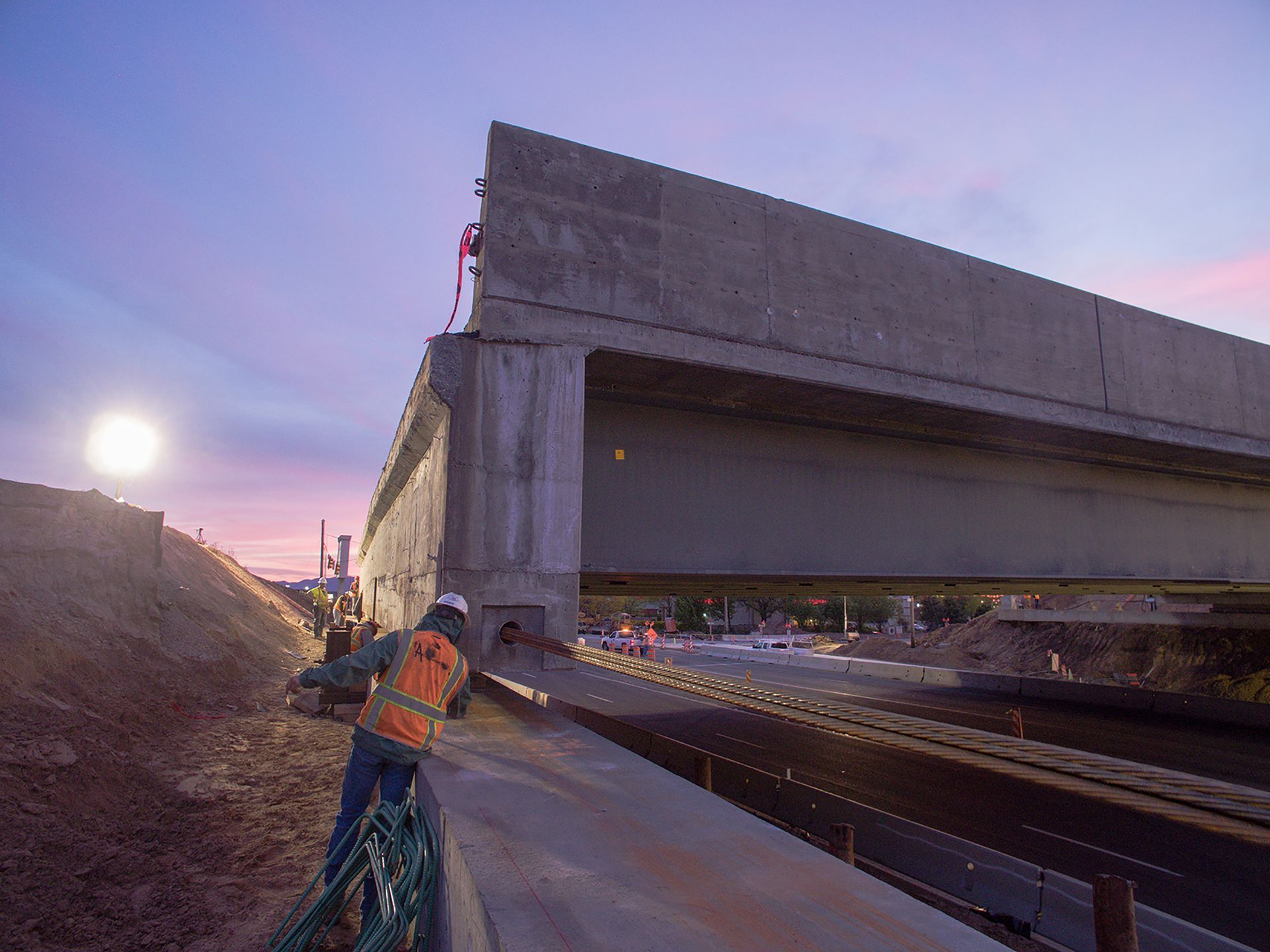
Over the course of its 40-year history in Utah, WSP's Salt Lake office—originally founded as Parsons Brinckerhoff in 1985—has morphed from primarily a transportation design firm to one that successfully operates in multiple civil engineering markets. The results of WSP's transformation the past decade into a more diverse outfit speak for themselves, with the 128-person Salt Lake office (with locations in Cottonwood Heights and South Jordan) posting three consecutive years of revenues over $50 million, including a record $70.1 million in 2023, and a robust $59.9 million in 2024—good for the No. 2 ranking in UC+D's 2025 Top Utah Engineering Firms rankings.
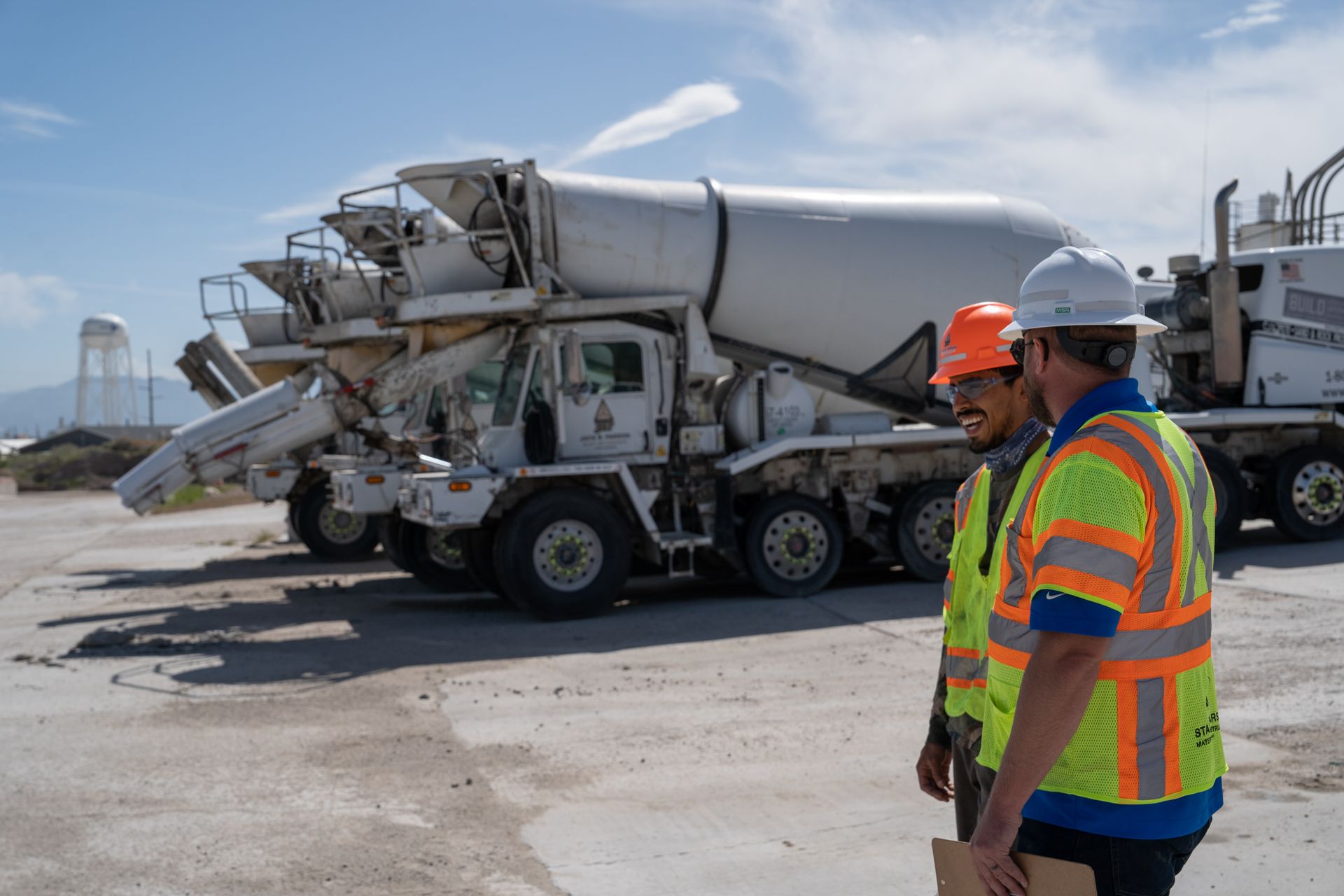
Lucio Gallegos vividly remembers the workforce development meetings he attended during his time at Ogden-Weber Tech. These career and technical education (CTE) discussions consistently focused on one thing: young people were not entering construction, and the industry needed a new approach to attract them. Gallegos recalled one member of the workforce development team, a training director with a prominent general contractor, saying, “We have been trying this for over 10 years, screw it, we’re just gonna hire them.” The Long Road Those conversations occurred nearly 10 years ago, and workforce development concerns continue to permeate the industry. The National Center for Construction Education & Research estimates that 41% of the construction workforce will retire by 2031, leading to potential gaps in skill and safety and decreases in productivity and project quality. While stakeholders have aligned on the overall goal of providing students a foundation for future success through career development, the means to achieve the ends were seemingly at odds. High schools, trade schools, colleges, and private industry took different paths to achieve their goals, with some moving in opposite directions. “I’m gonna be honest with you,” Gallegos recalled one school administrator saying, “If I promote what you’re telling me to get them over to the tech college, I lose head count. And then I lose teachers. I can’t have a school without teachers.” Jobs that took away student learning experiences, according to federal guidelines and child labor laws, made the idea a non-starter. However, after years of lobbying the Utah Legislature for a compromise between industry and education, H.B. 055, passed in 2023, provided a catalytic change in how younger people can engage with construction and other industries. High school students could participate if they were involved in a school-sponsored work experience and career exploration program. Private industry finally had the compromise it wanted. It was time to act. Big-D Charts New Path Gallegos, now the Workforce Development Manager from Big-D, joined the company in 2023 with the express purpose of creating a program that fit within the new guidelines. Gallegos said he sees career development through the lens of the immigrant experience, one he knows personally as a Mexican immigrant with a father who worked in commercial construction. “I was 9 years old and busting pins out of concrete forms with a hammer that was as big as I was,” he laughed. “I’ve got the cliché immigrant story.” That story has a theme familiar to many immigrant families, he said, one where parents say, “I want my kids not to have to work as hard as I do. I want them in school.” Add to that, it’s a law—children must attend school. Gallegos was unfazed by those obstacles. As he began planning how Big-D’s internship program would operate, he knew that engagement had to start at the elementary school level and build on personal relationships between private industry, school administrators, students, and their families to succeed. “We want to be the solution, not the obstacle to get into this industry,” said Gallegos. So Big-D removed the barriers. Students can still attend school, work towards graduation, and be available in the afternoon for sports, extracurricular activities, and the high school experience. But working was another significant part of the immigrant experience, Gallegos said, and internships needed to be paid to alleviate the family concerns. “We asked what we would pay somebody fresh out of high school who worked at Big-D,” Gallegos said. Interns have earned those same wages ever since.

On January 2, 1957, Gene Fullmer, a scrappy, underdog fighter from West Jordan stunned the boxing world with a 15-round unanimous decision over the legendary Sugar Ray Robinson at New York’s fabled Madison Square Garden. Fullmer captured the world middleweight championship and established himself as one of the best pound-for-pound boxers during the late 50s and early 60s. Since then, the Fullmer name has been synonymous with boxing in Utah, with brothers Gene, Jay, and Don establishing the Fullmer Brothers Boxing Gym in 1978, and offering free boxing instruction and life mentoring to thousands of youths—carrying on a tradition they learned from their trainer, Marv Jenson. Their legacy of community giving will live on in the new Fullmer Legacy Center in South Jordan, a 16,500-SF facility that will serve as a permanent home to the boxing gym—after years of bouncing around to various temporary facilities—along with a museum, snack bar, and gift shop. “The Fullmers are the first family of boxing in the state of Utah—that’s well understood,” said Dave Butterfield, a founding board member of the Fullmer Legacy Foundation. Butterfield served as Chairman of the Board from June 2016 to early 2025 and was influential in helping raise money—nearly $6 million via donations to date, which includes $2 million from the Utah Legislature. Project Driven by Vision to Find a Permanent Home for Fullmer Brothers Gym It was Jay Fullmer who led the charge to teach boxing in the community. By 1978, the Fullmer Brothers Boxing Gym had formally opened at the Butterfield farm chicken coop in South Jordan, recalled Larry Fullmer, Don’s oldest son and the man who spearheaded the efforts for the Fullmer Legacy Center. From there, Larry said the facility moved to Riverton Elementary, an old church house in West Jordan, a sugar factory, a former fire station, and the Salt Lake County Equestrian Park in South Jordan, where it had resided since 2011. When they got word that Salt Lake County planned to transfer ownership of the park to Utah State University, Fullmer knew they needed to find a long-term home for the boxing gym. Fullmer met with Butterfield and Robert Behunin—who at the time was a Vice President with Utah State University—in 2016 and told them he just wanted a “tin shed of our own” for boxing. Behunin countered by saying, “If you want people to donate money, you need something better than a tin shed!” They quickly formed the Fullmer Legacy Foundation (FLF), and by 2018, the wheels were in motion on a building. Doc Murdock, a long-time trainer at the gym, connected Larry with his former roommate at Brigham Young University, Vern Latham, who is a Principal at Salt Lake-based VCBO Architecture. VCBO offered pro-bono services initially while helping FLF put together an RFP, while North Salt-based Gramoll Construction provided value engineering and other services in an effort to get the project launched. Larry expressed sheer gratitude for the contributions of both firms in helping make the project a reality, especially for many generous donations from various foundations and individuals. “[VCBO] believed in us early on and did our first phase of planning at no charge—they have been amazing and so professional to work with,” said Larry. “Gramoll helped us get the budget done as tight as it could be. This project had the absolute tightest budget. We met weekly with architects and the general contractor to see the progress—I’ve never seen such an amazing process. Construction started in November ’23, and every time I would come to the jobsite in the first six months, I’d get emotional.” “We leaned on our relationships with contractors for flooring, ceiling, tiles, donated furniture and got deep discounts and a lot of in-kind donations,” said Phil Haderlie, Principal-in-Charge for VCBO. “To me, the story of this project is the grassroots effort of people seeing the value—this is something that came from their heart. It will have a long-lasting impact on the community.”

The first season is in the books for the Salt Lake Bees in its spectacular new home—the Ballpark at America First Square, the exciting new heart of Downtown Daybreak and certainly one of the premier Triple-A stadiums in the country. "It's a really cool stadium—the field looks so good!" gushed Eric Barton, Project Director for Salt Lake-based Okland Construction, while surveying the spacious 280,000 SF, 6,500-seat (8,000 capacity) ballpark. Barton said his team faced an extremely difficult construction schedule with the mandate the project had to be sufficiently ready for Opening Day 2025 on April 8, less than 18 months after the formal October 20, 2023, groundbreaking. Barton said Okland knew it was going to be a grind, with long hours and tight windows to get various milestones accomplished. "When we bid this to our trade partners, we had them bid it with the expectation of it being six days a week," he said. "We want not only your best guys, but you have to be adaptable to the plan. It was gangbusters from the start.” Up to 300 workers were onsite during peak construction activity, requiring meticulous coordination throughout. Okland even brought in Fred Strasser, a legendary project director who came out of retirement to shepherd the project through. "Fred is the genius behind getting this whole thing done," said Barton. The project was designed by Salt Lake-based HOK, who worked closely with the owner, Sandy-based Larry H. Miller Real Estate (LHMRE) and Miller Sports + Entertainment (MSE) to bring about a project that would add even more buzz to its wildly popular, 4,000-acre master planned Daybreak development in South Jordan, making it a true entertainment destination. The design weaves together best-in-class baseball experiences with year-round public amenities, including a recently opened Megaplex theater, a performing arts center, a large amphitheater, along with retail, restaurants, and apartments, with buildout continuing through 2027. Walking paths and open spaces create natural connections between The Ballpark and the surrounding neighborhood, making the area an iconic community asset and a true sports and entertainment district. Downtown Daybreak is slated to host more than 200 annual events—including the Bees’ 75-game regular season. Supporting this entertainment destination, the venue’s prominent location just off the Mountain View Corridor freeway makes it highly visible to passing traffic while providing easy access. The stadium is also connected to multiple transportation options, easily reached by walking, biking or light rail across the Wasatch Front, and by car from the new freeway corridor. The Ballpark site drops 20 feet from the loading dock to the plaza, managed through terraced spaces that echo the region’s mining heritage. Though the slope stays gentle at under 5%, carefully placed stairs and planters make walking comfortable while honoring the industrial past. The center field main entrance connects to light rail, while a formal plaza at home plate serves as a second entrance, primarily for VIP access. The street design follows Daybreak’s established standards for lighting and tree spacing. Bike racks at the light rail station and plaza make cycling to games convenient. Utah’s Landscape Shapes Design The Wasatch Mountains, visible from every angle of the ballpark, directly influenced the ballpark's design. Throughout the venue, carefully planned viewpoints frame these mountain vistas. The structure resembles this mountainous setting in its form, transitioning from solid brick and concrete at its base to lighter materials—metal and expansive glass—as it ascends. Working with Kansas City-based architectural metal fabricator Zahner, HOK and MSE created a distinctive facade using perforated metal panels that suggest Utah mountain peak silhouettes from Ben Lomond Peak in Weber County to Mt. Nebo, the southernmost and highest mountain in the Wasatch Range of Utah. These panels transform into a glowing display at night, serving as a lantern on The Ballpark’s ‘front porch’ and welcoming visitors. This connection to Utah’s landscape flows throughout the site. Angular planters guide visitors along pathways, while public spaces are arranged in terraces that echo the mountainside. The copper colors and stepped surfaces of the nearby Kennecott Mine inspired the ballpark’s materials and layout. Inside, the decor features warm copper, gold and honey tones, with textured materials that blend the natural landscape with the Salt Lake Bees’ team colors.






















